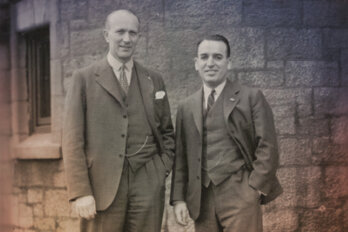Zug island, home to one of the largest steel mills in the United States, is an undeniably creepy place. To get close, you must drive to the southern shore of Detroit’s ravaged Delray neighbourhood. You’re unlikely to encounter other humans, but you’ll pass crooked houses, brick facades fronting non-existent buildings, and the remains of a Roman Catholic church, stained glass long shattered. Despite the ghostly surroundings, the island is eerily alive—a sinister mess of belching towers and twisted tracks on which railcars carry liquid pig iron from soot-black furnaces to a nearby finishing plant.
The site was once an Indigenous burial mound containing hundreds of human skeletons. In 1888, workers detached the island from the mainland to accommodate a shipping canal. Since the Detroit Iron Works took over in 1901, Zug has produced hundreds of millions of tons of steel, been the site of gruesome injuries and deadly explosions, and provided fodder for more than a few local legends. The SS Edmund Fitzgerald, a giant freighter that sank inexplicably into Lake Superior in 1975, was supposedly destined for Zug, and there are rumours of a top-secret penitentiary on the island.
Hearers possess the most useless superpower imaginable—there’s little but grinding and rumbling at the bottom of the sound spectrum.
Last February, I stood on the shore of the narrow turquoise canal, watching the towers churn smoke into the sky. I was there to investigate the latest Zug Island mystery: a spectral, low-frequency noise that has been plaguing residents on the other side of the waterway—in Windsor, Ontario, and surrounding Essex County—since at least 2011. People refer to the disturbance as the Windsor–Essex County hum; it’s a deep, vibratory rumble that’s more physical sensation than sound. “You can’t tune it out,” says Mark Letteri, a philosophy professor at the University of Windsor. “You can put on headphones, but you’re still going to feel it in your body.”
For those who can hear it, the hum is invasive and unsettling. It rattles windows, makes sleep unattainable, and reportedly sends dogs into fits of hysteria. For years, a small group of Canadians, known as “hearers,” has been trying to convince the rest of the world that it exists at all.
Five years ago, Letteri first heard what he took for faraway jackhammers outside his window. “I thought, that doesn’t make sense,” he says. “Why would somebody be doing construction at 10 p.m.?” When Mike Provost, a retired insurance salesman in the Windsor neighbourhood of Old Sandwich Town, first noticed the noise, he attributed it to thunder rumbling over nearby Lake Erie. “I thought, Gee, there must be a storm over the water, but I looked up and the skies were as blue as blue can be.” In October 2015, Liz Paszkowiak-Gillan, a mother in rural Amherstburg, Ontario, listened, terrified, as what she thought was a semi truck idled outside her house around 1 a.m. “I’m in the middle of nowhere, and I’ve got hardly any neighbours around me,” she says. “I must’ve gone to the window a good three or four times that night, and I definitely didn’t sleep.” There was nothing there.
There are few places in Windsor–Essex County where you’re shielded entirely from industrial noise, whether from the Windsor salt mines, the McGregor Quarry, or the surrounding automotive factories. For most people, these are minor nuisances in a place with affordable homes and tree-lined streets. And in any case, those disturbances follow predictable business hours. The Windsor hum is different.
For the last four years, Provost, the man who first mistook the hum for thunder, has been keeping track of noise disturbances on his property. He’s a goateed, burly guy, youthful for a grandfather who walks with a cane. Last February, at his split-level house, he handed me a binder larger than War and Peace. It was full of entries—at least 20,000—noting the time, date, type, and intensity of every intrusive sound. From his living room, I could hear the ticking of multiple clocks, only some of which were set to the right time.
His records mention hums, as well as pulses, vibrations, and pressure releases, which he likens to “the Enterprise going into warp speed.” In careful handwriting, he grades each sound from one to ten, depending on its volume; he has collected more than eight terabytes of audio files from three digital recorders mounted in his backyard.
Provost is, by far, the most active poster on the Windsor–Essex County hum Facebook page, which has nearly 1,500 members. He types out and uploads his notes to the forum daily and, until recently, sent between 150 and 200 pages of records every month to the federal environment minister, the minister of foreign affairs, the prime minister, and the two Windsor-area MPs. He has tried to get other Facebook posters to do the same—corroboration would help get the government’s attention. “We shouldn’t have to put up with this day in and day out,” he says.
The Facebook page has a small cadre of participants: mostly hearers, but also a few conspiracy theorists and trolls. One poster laments the “lack of empathy and support from local mayors” and the sense of “frustration” that comes “from not being understood.” Another suggests that the hum may have links to the Russian Woodpecker device, a Soviet radar system rumoured to have been used in mind-control experiments. Yet another tells Provost to “stop doing acid.”
Windsor isn’t the first municipality to be plagued by inexplicable low-frequency rumbles. In 1973, New Scientist ran a story about people who were afflicted by “a low throbbing background noise that no one else [could] hear.” Such complaints were most pronounced in the British port city of Bristol, but, by the 1980s, similar noises were haunting citizens of Largs, a Scottish vacation town. The disturbance hit Middle America in the early ’90s, first reported in Hueytown, Alabama, and then Taos, New Mexico. (Agent Fox Mulder mentions the latter on an episode of The X-Files.) Hearer communities now make up a constellation of seemingly arbitrary dots on a map: rural Oklahoma; coastal Massachusetts; southwest Germany; the suburbs around Sydney, Australia; Calgary; and, more recently, Toronto’s Leslieville neighbourhood.
The locations seem random, but the narratives are similar. News reports describe the sound as omnidirectional and low-pitched, like a slow-moving train or, as many have put it, “an airplane stuck in the sky.” The phenomenon could be rooted in hysteria, but then why are the complaints so localized? Hum hearers, for the most part, reside in a few specific places. Explanations range from the prosaic (factories and industrial infrastructure) to the outlandish (transmissions from outer space, residual noise from the Big Bang, or bizarre atmospheric activity caused by haarp, the Alaska-based project in which researchers sent high-frequency radio signals into the upper atmosphere from the mid-1990s to 2014).
In 2002, the Board of Public Works and Safety in the city of Kokomo, Indiana, commissioned a study in response to a decade of hum complaints. Researchers triangulated the noise to two sources: a cooling tower at a DaimlerChrysler factory and an air compressor at a plant owned by metal-alloy manufacturer Haynes International. That discovery offers strong evidence that these noises come from industrial sources. Those who prefer paranormal theories, however, point out that, although Chrysler and Haynes enacted measures to quell their noise emissions, the Kokomo hum hasn’t entirely disappeared.
When hum complaints ramped up in 2004 in Auckland, New Zealand, Tom Moir, a signal engineer at the Auckland University of Technology, was skeptical. Still, he visited one hearer at her home, where he played her low-volume tones below sixty hertz—a frequency near the bottom end of the audibility spectrum. (The human voice, by comparison, has a fundamental frequency of about 200 hertz for women and 125 for men.)
Moir instructed the woman to turn her back to his controls. He switched the sound off and on and told her to alert him when she heard the changes. “She got it right 100 percent of the time,” he says. Moir returned to his office the next day, where he played the tone all afternoon to see whether he could develop the ability to hear it, too. He didn’t, but hours later, a student walked in and inquired about “the awful noise.”
Low-frequency sound can be surprisingly robust. It permeates concrete walls and travels across extraordinary distances. Seismologists detect earthquakes thousands of kilometres away by measuring low-frequency ground vibrations, and it’s said that during the Napoleonic Wars, the cannons of France were audible in England. Such noises also seem to hover in the air, unmoored from traceable sources. The brain determines noise direction by measuring the time lapse between when a sound hits one ear and when it reaches the other. But low-frequency sound waves are longer than the diameters of our skulls. They appear to reach both ears simultaneously, confounding our ability to figure out where they come from.
Just as there are super tasters, there seem to be super hearers, too. Almost all of us can hear sounds in the twenty- to fifty-hertz range if they’re loud enough, but a few of us can hear them even when they’re quiet, which may explain why hum hearers are outnumbered by the happily oblivious. Hearers possess the most useless superpower imaginable, since there’s little but grinding and rumbling at the bottom of the sound spectrum. Moir himself is still incapable of tuning in. “I don’t really want to hear the rubbish down there anyway,” he says.
In 2011, the Windsor hum became a local media sensation, and, in 2012, the community established a hum hotline. More than 10,000 people called in to complain—enough to convince Ontario’s environment ministry to conduct a two-month study that involved placing sound sensors in residential and industrial locations. The federal government hired Colin Novak, an acoustic engineer at the University of Windsor, to further investigate one of the noisiest spots on the ministry’s map: the banks of the Detroit River, which separates Canada from the United States.
Zug Island, Michigan, is owned and operated by the United States Steel Corporation, which tightly restricts access to its 1,900 employees. (US Steel declined to comment for this story.) Adam Makarenko, a Toronto filmmaker working on a documentary about the hum, recalls approaching the island with a camera and “getting cornered right away by security guys in Broncos.” On the site, the clamour of industry is all around: jackhammer-like chugging, horn blasts, and a faint, omnipresent ring.
To sift through this cacophony, Novak installed two monitors equipped with sound-analyzing software, one on the Canadian side of the river and another that rotated between various hearers’ residences. A few years ago, he also made occasional boat trips to the edge of the island, bringing with him a pentangular array—a spiky gadget outfitted with thirty microphones, which produce high-level data on sound direction. During one such trip, a boat carrying men with binoculars trailed him in the night.
For the first four months of the experiment, Novak found nothing. Then, around midnight one evening in early July 2013, the exhaust stacks at Zug emitted a ghostly blue flame and Novak’s censors caught a thirty-five-hertz rumble emanating from the island—one that was detectable at Windsor homes four kilometres away.
The steel-making process, he says, is “a black magic art” in which iron and limestone are bombarded with superheated air at temperatures as high as 1,700 degrees Celsius. A blast furnace that hot pulsates with energy. “The whole structure will come alive,” says Novak, “and the walls will move in and out like a massive speaker, emitting a giant roar.” Sound refracts as it travels. At a remove of several kilometres, that roar could be heard as an oscillating, low-frequency hum.
Clearly, there is a hum in Windsor, although by Novak’s reckoning, it isn’t as constant as some residents make it out to be. He suspects that in 2011 and 2012, when hum complaints were rampant, US Steel was producing something that taxed its blast furnaces beyond their normal capacity. After 2013, reports dwindled, suggesting that the company had altered whatever strange operations were behind the worst of the noise.
But after the disturbance subsided, a cadre of about fifty people continued to be haunted. They logged complaints at city hall and risked ridicule by posting regularly on the hum Facebook forum. They might have gone unnoticed, except that on April 17 of this year, Windsor–Essex County was besieged by a window-rattling, bone-shaking racket, prompting the Windsor Star to proclaim that the Windsor hum’s noises “were some of the worst in years.” This time, Provost and his counterparts were ready to grant interviews with the Globe and Mail and the Guardian. Brian Masse, a Windsor-area MP, went to Washington this past June to discuss regulating noise emissions from the Detroit region.
But the mystery still hasn’t been solved. Novak’s research suggests that the Windsor hum is a sporadic phenomenon, most likely the product of operations at Zug Island. But if that’s true, why do a handful of people hear the noise all the time? A conceivable, albeit farfetched, explanation is that some Windsor–Essex County residents are tuning into another sound entirely: the worldwide hum.
That theory, despite online forums with hundreds of believers, isn’t grounded in peer-reviewed evidence. Perhaps the most credible resource is a 2004 article by David Deming, a hum hearer and University of Oklahoma geophysicist, from the Journal of Scientific Exploration. His work has been aided by the findings of Glen MacPherson, a high-school teacher in Sechelt, British Columbia, who operates a database marking the locations of thousands of individual hum hearers around the world—evidence, for him, that the phenomenon is global. In his article, Deming cycles through popular hum explanations, ending with the one he favours: Take Charge and Move Out (tacamo), a US Navy program in which roving airplanes send very-low-frequency (VLF) radio signals to submarines.
tacamo was established in the Kennedy era to create a mobile communication system that could take over if America’s facilities were destroyed in a nuclear attack. Deming argues that some hum locales coincide with likely sites of tacamo testing. Since tacamo airplanes are constantly on the move, the phenomenon could crop up anywhere in the world. There’s lab-based evidence that some people, when exposed to VLF radio waves, experience strange acoustic sensations.
Expert consensus on the hypothesis linking VLF radio, tacamo, and a global hum is that it’s theoretically possible, but highly unlikely. A more plausible hum explanation can be found in the study of psychoacoustics, a branch of psychology that considers how states of mind affect sound perception.
Low-frequency noise is all around us—the by-product of exhaust fans, cooling towers, swimming-pool pumps, tires on asphalt, electric wires vibrating in air, and wind swishing over dips in the landscape. Imagine you are a Windsor resident born with an enhanced ability to hear such sounds. In 2011 and 2012, you were bombarded with frightening, sleep-disrupting noises from the direction of Zug Island—noises that, for understandable reasons, you fixated on. By fixating, you trained your brain to distill such sounds from the ambient metropolis, and now you hear them all the time. Are they real, or the product of human obsession? The answer, perhaps, is both. What you hear is, in part, determined by what you listen for.
At the end of my meeting with Provost, we go out on his deck so he can smoke. He tells me that he hears the hum at that very moment, albeit softly—he grades it a two out of ten—and I confess that I hear nothing except wind and children playing in a nearby backyard. “I’d feel a lot better,” he says, “if US Steel would go, ‘Yeah, it’s us. We’re working on fixing it.’” He acknowledges, however, that, without sustained media attention and government interest, there’s only a slim chance a major US corporation will admit to a group of Canadians that it’s responsible. “I’ve been told that this has become a hobby, and I guess I’d have to agree,” he admits. “They don’t make model cars like they used to.” He looks down at the logbook in his lap. “It takes up all of my time.”
This appeared in the September 2016 issue.





